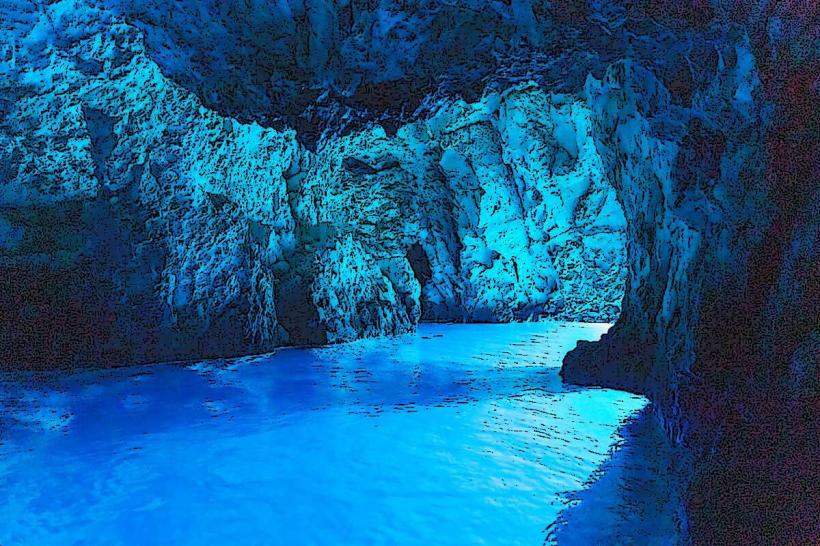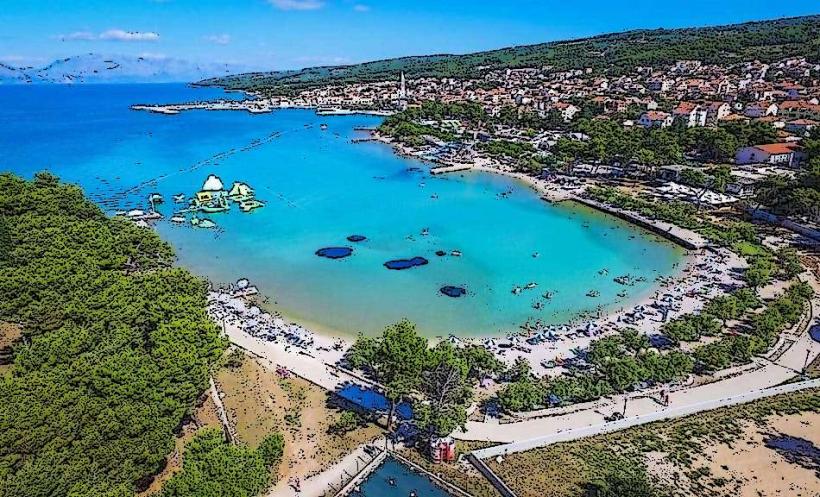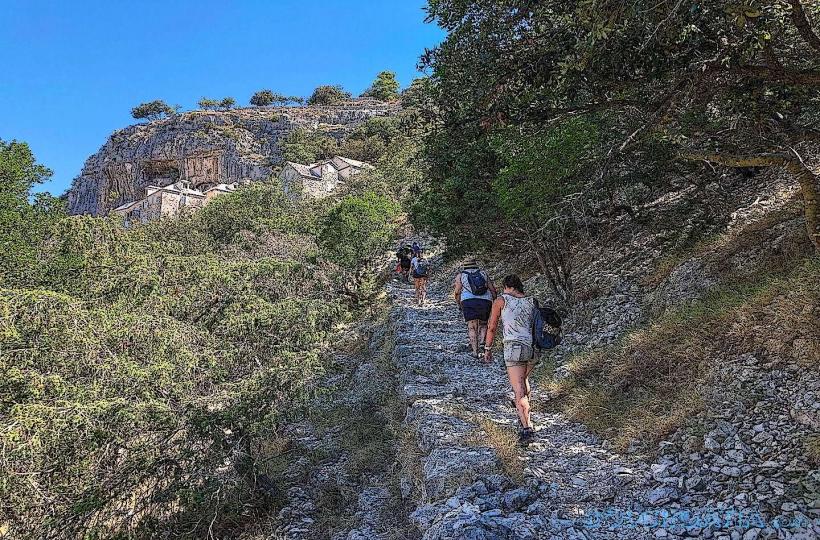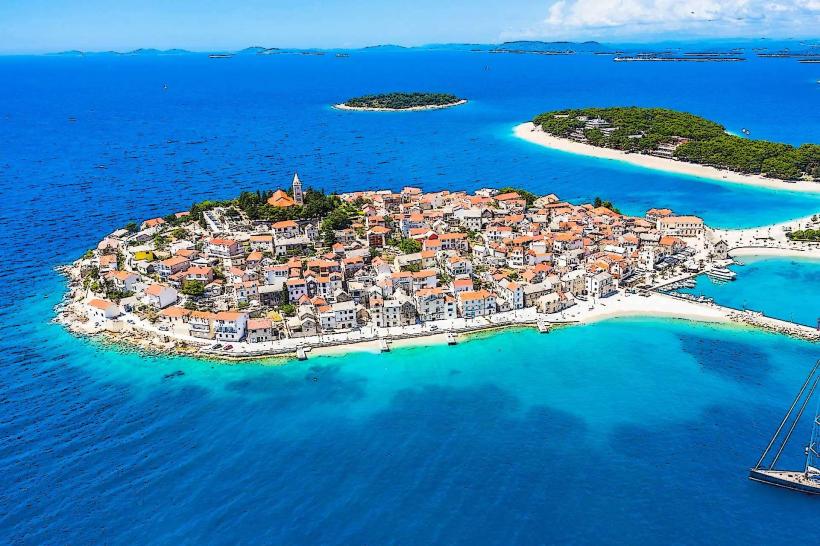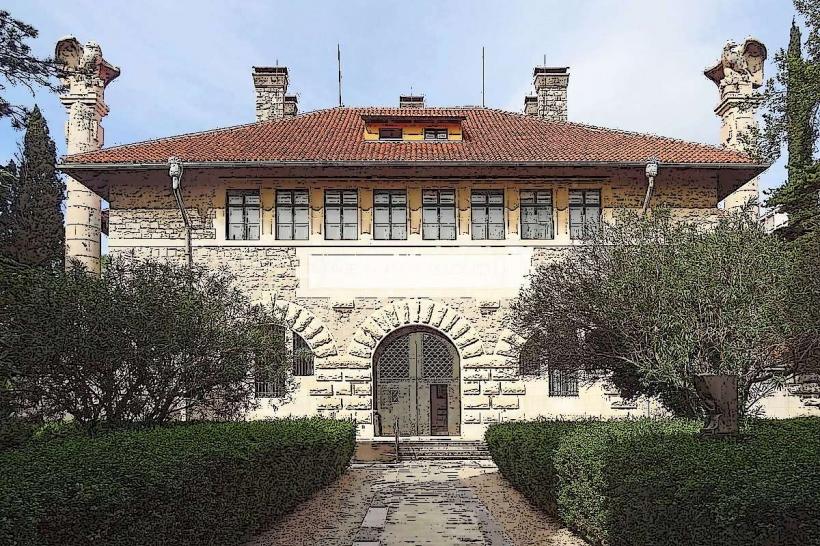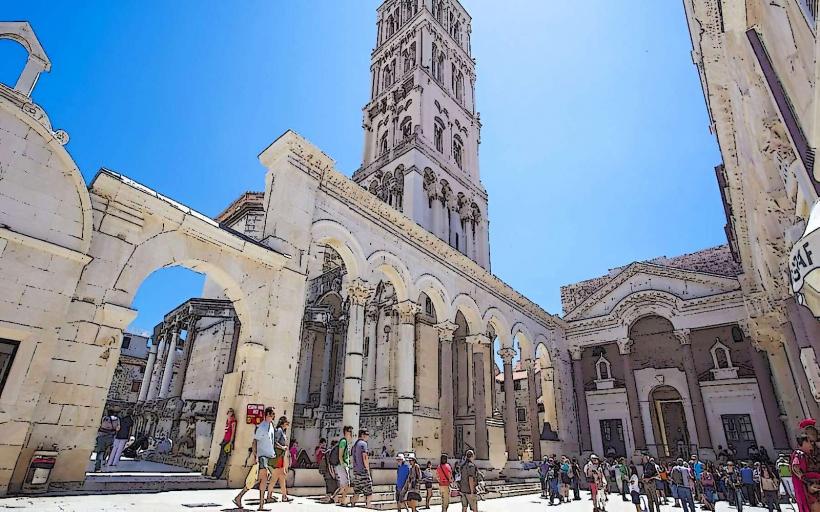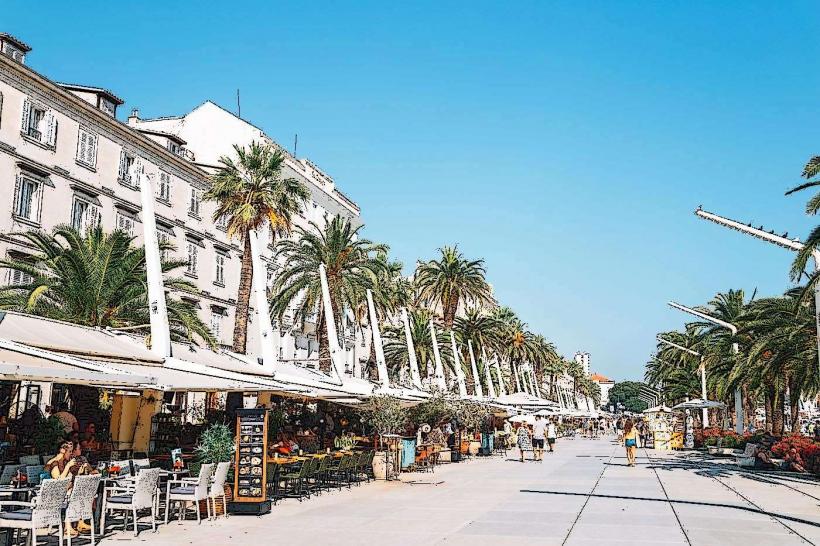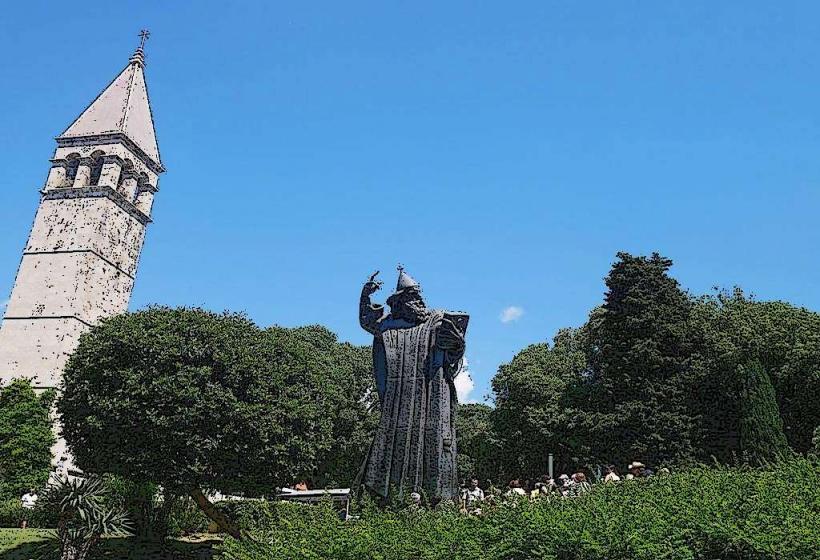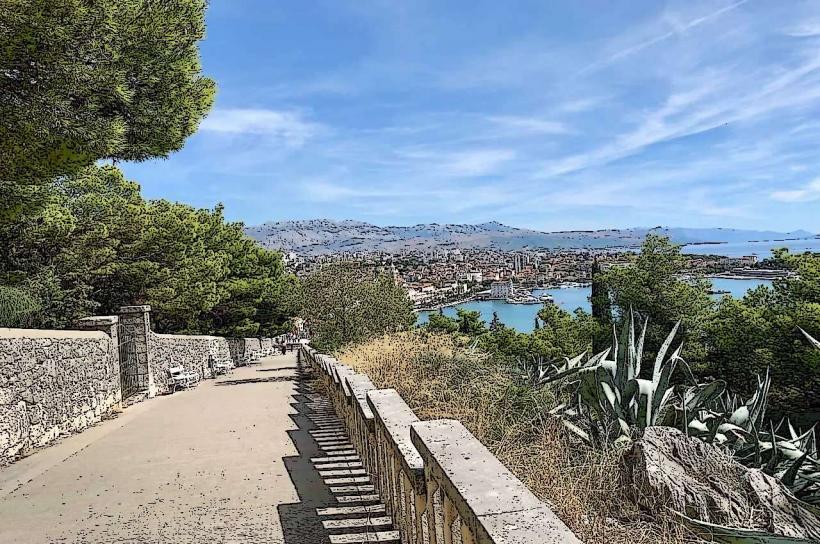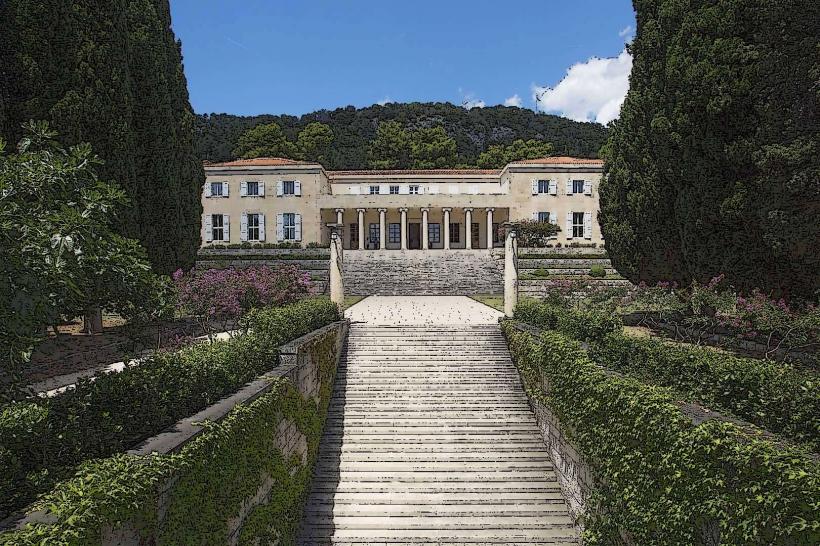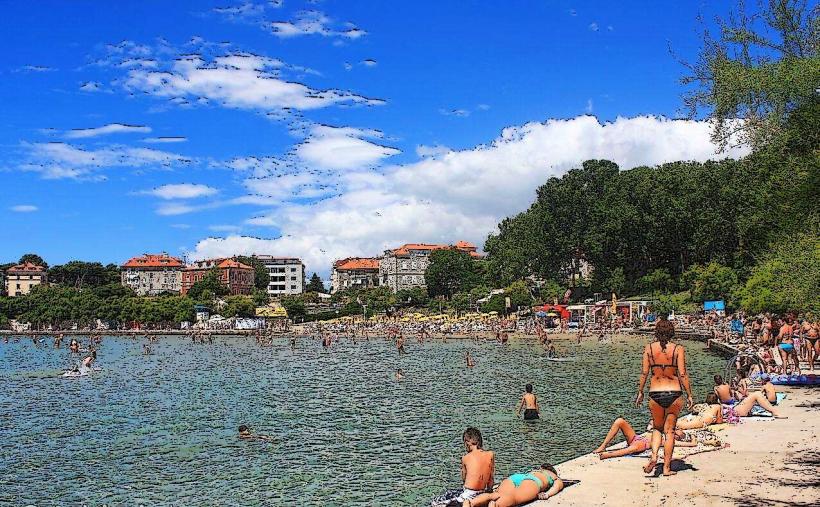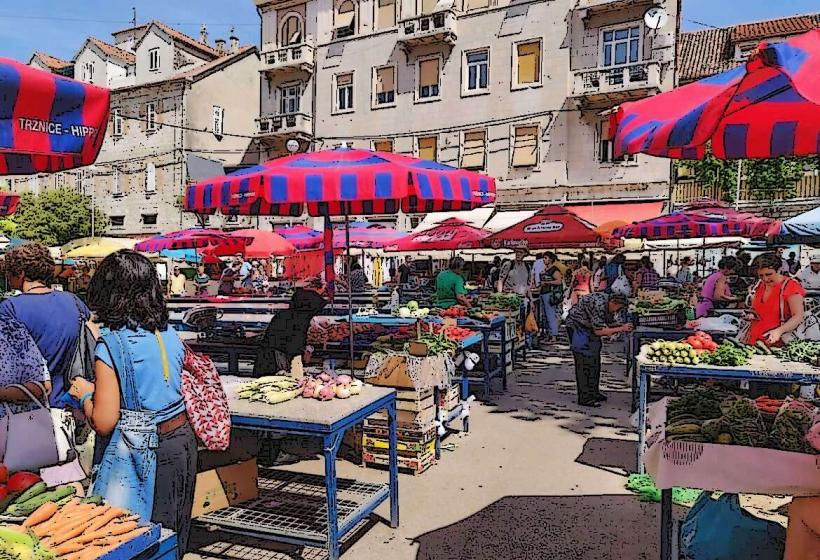Information
Landmark: Diocletian's PalaceCity: Split
Country: Croatia
Continent: Europe
Diocletian's Palace – Split
Diocletian's Palace is one of the most iconic and best-preserved Roman monuments in the world, located in the heart of Split, Croatia. It was constructed as a retirement residence for the Roman Emperor Diocletian in the early 4th century AD, around 305 AD, and spans a vast area of about 30,000 square meters. Over the centuries, the palace has transformed into a vibrant part of the modern city, with the ancient structure seamlessly integrated into Split’s urban life.
Historical Significance
- Emperor Diocletian: The palace was built by Emperor Diocletian, who ruled the Roman Empire from 284 to 305 AD. He commissioned the construction of this grand palace near the coastal city of Salona (today’s Solin, close to Split) for his retirement. Diocletian was known for his administrative reforms, but after abdicating in 305 AD, he sought a peaceful retirement, surrounded by luxury and a fortified residence.
- Roman Architecture: The palace was not only a retirement home but also a military stronghold, featuring fortifications and defensive walls. It was designed as a self-sufficient complex with everything Diocletian might need: a temple, baths, residential areas, and even a military complex. The palace was laid out in a grid pattern, and the layout remains impressive even today.
- UNESCO World Heritage Site: The palace was inscribed as a UNESCO World Heritage site in 1979 due to its historical significance and exceptional preservation. The structure is an outstanding example of Roman imperial architecture and serves as a direct link to the ancient Roman Empire.
- Split’s Old Town: Over time, the ancient palace became the heart of Split's Old Town. After Diocletian’s death, the palace was abandoned, but later, residents began to move into the ruins, and parts of the palace were repurposed for housing and commerce. This layering of history, where ancient ruins are still part of a vibrant modern city, is one of the most remarkable aspects of the site.
Structure and Layout of the Palace
The Diocletian's Palace is a vast and elaborate complex that blends imperial Roman design with practical fortifications. It consists of several key areas, each with a distinct function.
Perimeter Walls: The palace is surrounded by massive walls built with Roman stone and reinforced with towers and gates. The walls are about 2 kilometers in total length and include four main gates that open to different parts of the city. The walls were intended to protect the palace from potential attacks and invasions.
The Four Main Gates:
- Golden Gate (Zlatna vrata): The main entrance of the palace, located on the northern side. It was the ceremonial entrance, and its decoration features reliefs and inscriptions related to Diocletian’s reign.
- Silver Gate (Srebrna vrata): Situated on the eastern side, leading to the city and the waterfront.
- Iron Gate (Željezna vrata): On the western side, used for entry from the harbor area, connected to the sea.
- Bronze Gate (Brončana vrata): Located on the southern side of the palace, opening to the harbor.
The Peristyle: At the center of the palace is a large courtyard called the Peristyle, surrounded by columns. This space served as the heart of the palace and was used for ceremonies and public gatherings. It is still an impressive area today, with the original columned arcade and steps leading to the Emperor’s quarters.
The Temple of Jupiter: One of the most significant features of the palace is the Temple of Jupiter, built in honor of Diocletian’s god and the Roman emperor cult. It later became a Christian church, and today, it houses a Baptistry used for Christian rites. The temple's rotunda is a striking example of Roman religious architecture.
The Vestibule: The Vestibule is a large, circular room located near the northern entrance. It features a dome and was used as a reception hall. The architectural design of the Vestibule is an excellent example of Roman engineering, and its grandeur emphasizes the importance of Diocletian's residence.
The Emperor’s Apartments: Diocletian’s private residence was located on the upper floors of the palace, where he could enjoy views of the Adriatic Sea. These apartments were luxurious and included a banquet hall, private rooms, and a viewing platform.
The Cellars: Below the palace’s main floors are the famous cellars, a series of underground chambers that were originally used for storage and possibly as slaves’ quarters. The cellars are particularly well-preserved and serve as a glimpse into the construction of the palace. They are now open to visitors and host art exhibitions and events.
The Transformation into Modern Split
- Living Spaces: Over the centuries, the original imperial palace became integrated into the developing city of Split. As early as the 7th century, inhabitants began moving into the ruins of the palace, repurposing its structures for homes, shops, and churches. Today, much of Split’s Old Town is actually part of Diocletian's Palace, with its walls, courtyards, and streets forming the modern urban landscape.
- Repurposed Architecture: Many of the medieval and Renaissance buildings found within Split’s Old Town have been built using materials sourced from the palace. For example, marble columns and stone blocks from the palace were used in the construction of churches and homes.
- Modern Urban Life: The blending of ancient Roman architecture with modern Croatian life is one of the most striking aspects of the palace today. Visitors can wander through its labyrinth of streets and alleys, where they will encounter cafes, shops, homes, and restaurants nestled within the palace’s ancient walls.
Attractions and Points of Interest within Diocletian’s Palace
Peristyle and the Sphinxes: The central courtyard is home to several Egyptian Sphinxes, which were brought to the palace from Egypt by Diocletian. These iconic statues are a reminder of the emperor’s affinity for grand architectural statements.
The Cathedral of St. Domnius: Built within the remains of Diocletian’s mausoleum, the Cathedral of St. Domnius is a functioning church and a significant Romanesque structure. It is one of the oldest Catholic cathedrals still in use and contains Christian relics and marble columns from the original structure.
The Diocletian's Palace Cellars: The cellars are one of the best-preserved parts of the palace and are now used for exhibitions. Visitors can explore these underground rooms and see where the palace’s original infrastructure remains intact.
Jupiter’s Temple: Originally a Roman temple dedicated to Jupiter, the building was later repurposed as a Christian church. It houses the Baptistry today and is an impressive example of religious transformation over time.
The Golden Gate: The Golden Gate serves as the main entrance to the palace. The gate is a Roman triumphal arch, and its decoration includes carvings and reliefs related to Diocletian’s reign and military campaigns.
Visitor Experience and Practical Information
- Access: Diocletian’s Palace is located in the center of Split, and its boundaries are often indistinguishable from the rest of the city, as modern buildings are built within the ancient walls.
- Admission: While the palace itself is free to explore, certain parts of the palace, such as the Cathedral of St. Domnius, Jupiter’s Temple, and the cellars, require an entry fee. Tickets are usually available for individual attractions or a combined ticket.
- Best Time to Visit: The palace is open year-round, but to avoid crowds, it is best to visit early in the morning or later in the evening, especially during the summer months. The palace is a great place to explore both during the day and at night when it is beautifully illuminated.
Why Visit Diocletian’s Palace?
- Historical Significance: Diocletian’s Palace is one of the best-preserved examples of Roman imperial architecture and is key to understanding the history of Roman Dalmatia and the transition to Christianity in the region.
- UNESCO World Heritage: As a UNESCO site, it is a remarkable piece of world history, offering visitors a chance to step inside a living Roman monument.
- Cultural Hub: Today, the palace is the heart of Split, a bustling cultural center filled with shops, cafes, restaurants, and public squares.
- Unique Blend of Ancient and Modern: The combination of ancient ruins with modern urban life makes a visit to the palace an unforgettable experience.
In summary, Diocletian’s Palace is not just an archaeological site but also a vibrant part of Split's everyday life, offering visitors a chance to connect with ancient Roman history while enjoying the lively atmosphere of one of Croatia's most beautiful cities.

